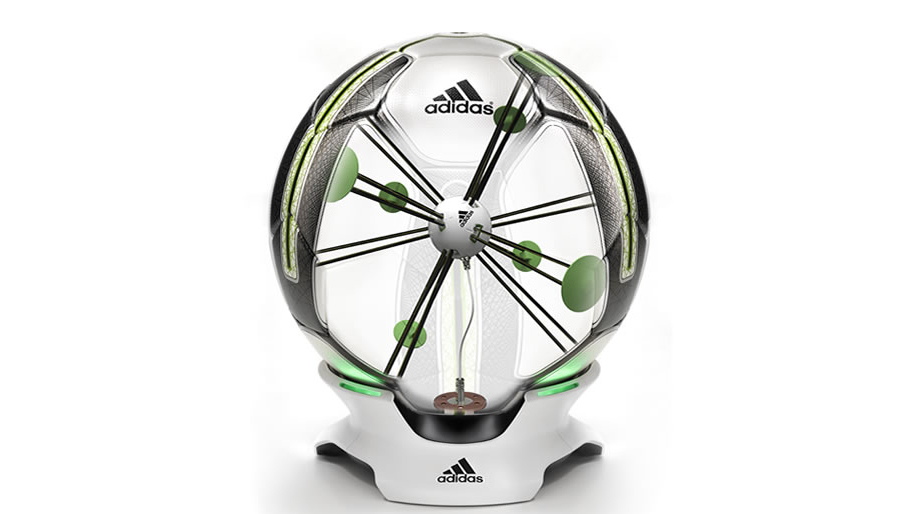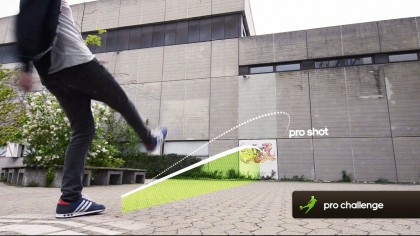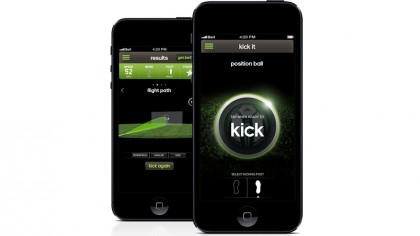The sensor-packed football that teaches you how to be a better player
Get real-time feedback from every kick

TechRadar spent some time with the new MiCoach SmartBall from Adidas – one of the first to draw data from your every kick.
The new MiCoach ball from Adidas looks like a spider accidentally exploded inside a normal ball. A small, round sensor in the middle of the sphere is held in place by a number of rods which press against the inner bladder of the ball.
"We have two sensors in there: an accelerometer and magnetometer, which can analyse the flight pattern of the ball, the speed, spin, bend, trajectory and football contact location," Christian DiBenedetto, Senior Innovation Director at Adidas told us.

"We used the same bladder as a normal ball, pumped it up to the same pressure, then suspend it on non-stretch loop of rubber and Kevlar. That suspension keeps the package in centre of the ball, so that even when the ball makes contact with something, that [sensor package] will never move from the centre of the ball."
The MiCoach Smartball comes with a dedicated app, which it communicates with wirelessly using Bluetooth 4.0 low energy. The set up is very simple: fire up the app, select the foot you're intending to kick with and then just wallop the ball as hard as you can, with the results of where and how fast you kicked the ball appearing in moments.
There's more to it than that though: with the app you can choose to focus on how you bent the ball, how much spin you put through it or even take on pro challenges, where users are tasked with mimicking kicks from professionals.
The data can all be saved to help you track your progress over time, as well as letting you share the information with a number of people on Twitter and Facebook who probably don't care.
Get daily insight, inspiration and deals in your inbox
Sign up for breaking news, reviews, opinion, top tech deals, and more.
When is it too much data?
Some people, when we described the technology, were in awe of the concept. However an equal amount were nonplussed, questioning why you'd want to know such things.
It's a good point: with sports brands looking to eke performance out of every single area of every game using wearable technology and sensors, when does it become overload? Why make a MiCoach ball at all?
"People want to see results," says DiBenedetto. "They especially want to see the results of a faster kick. Before they would kick the ball, and say it felt faster, but didn't know for sure; now they do.
"It's about giving feedback you would never otherwise get. Feedback of data that's actually really important [for improvement] and you can put it into your next kick."
That's where the set up comes into its own, as while you get lots of information on all the things you've just done, a huge portion of the app is dedicated to helping you translate that into real-world use.

Videos of professionals at key points in the leg swing show how to apply bend and swerve as well as improving power, meaning a child with nothing more than a ball and their father's iPad (that the cheeky mite swiped when he wasn't looking) can instantly improve dramatically.
And here's the good news: while DiBenedetto wouldn't be drawn on any specifics, he did confirm that the ball wouldn't cost the earth (and that the app would be free).
"[The MiCoach ball] is going to be affordable so everyone that wants to get better can do so, making sure it's within their reach."
Sadly we'll have to wait until 2014 to get see this technology in the shops, but it's definitely something that we can see brought down to the football pitch for a competitive practice session – a multiplayer game allows you to play against a friend to create the 'best kick'.
There will come a time when 'data apathy' in sports creeps in, but right now we're at the start of something impressive where things we could only guess at can be tracked and analysed – and in a way that's affordable enough for the average consumer too.
- Could you kick this with boots weighing just 99g? Check out our exclusive look at the futuristic F50 concept from Adidas.

Gareth has been part of the consumer technology world in a career spanning three decades. He started life as a staff writer on the fledgling TechRadar, and has grew with the site (primarily as phones, tablets and wearables editor) until becoming Global Editor in Chief in 2018. Gareth has written over 4,000 articles for TechRadar, has contributed expert insight to a number of other publications, chaired panels on zeitgeist technologies, presented at the Gadget Show Live as well as representing the brand on TV and radio for multiple channels including Sky, BBC, ITV and Al-Jazeera. Passionate about fitness, he can bore anyone rigid about stress management, sleep tracking, heart rate variance as well as bemoaning something about the latest iPhone, Galaxy or OLED TV.